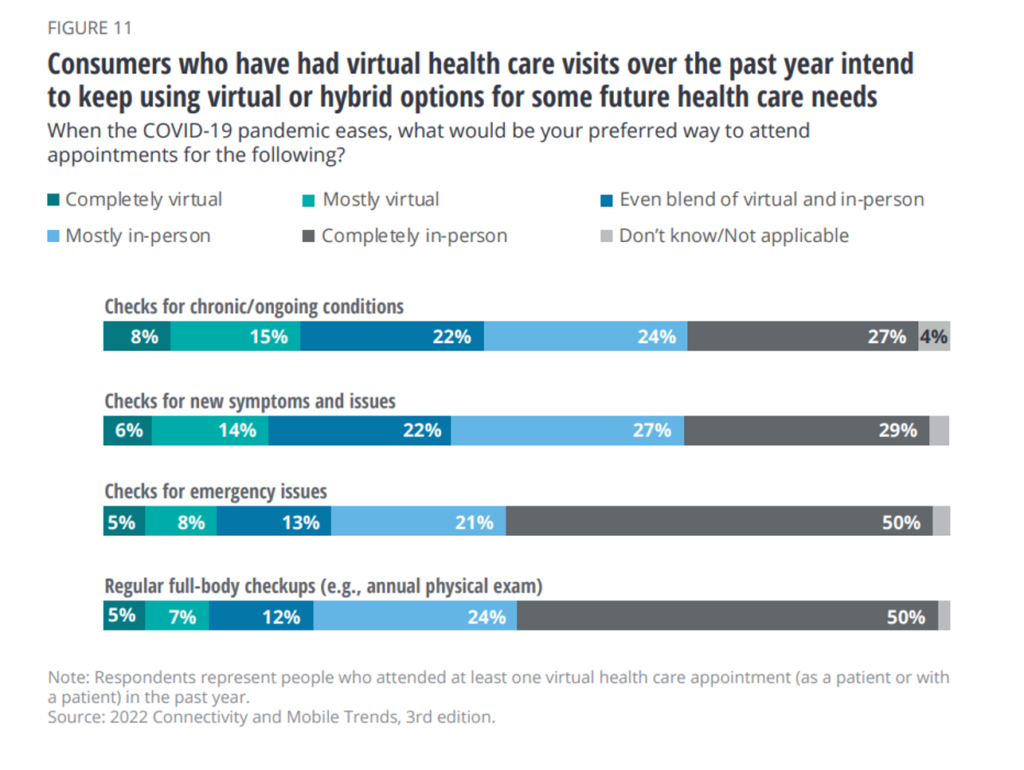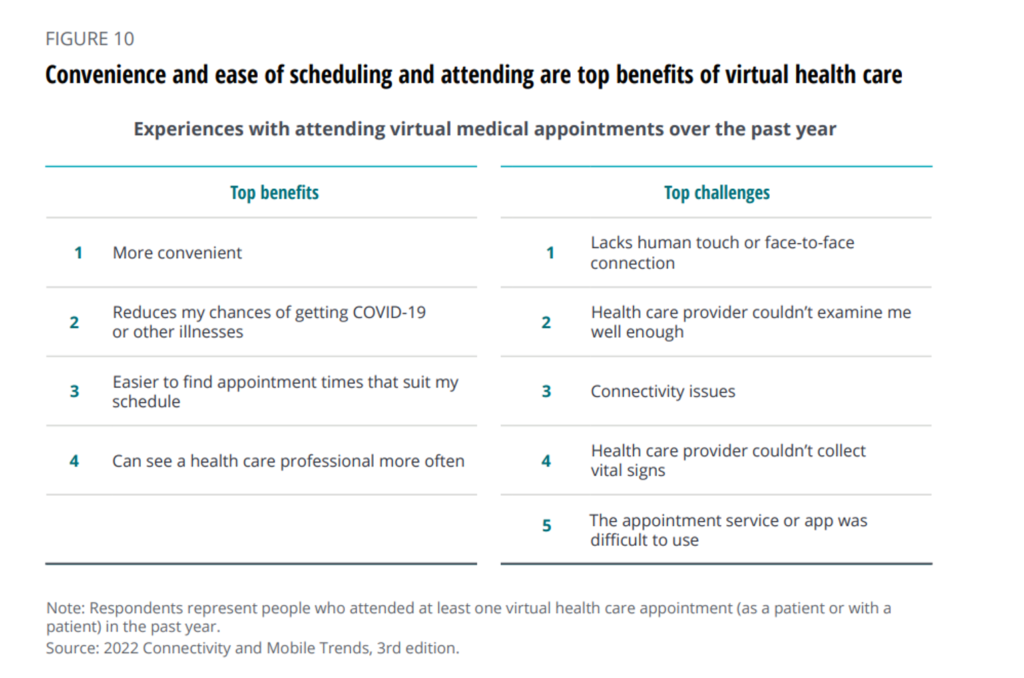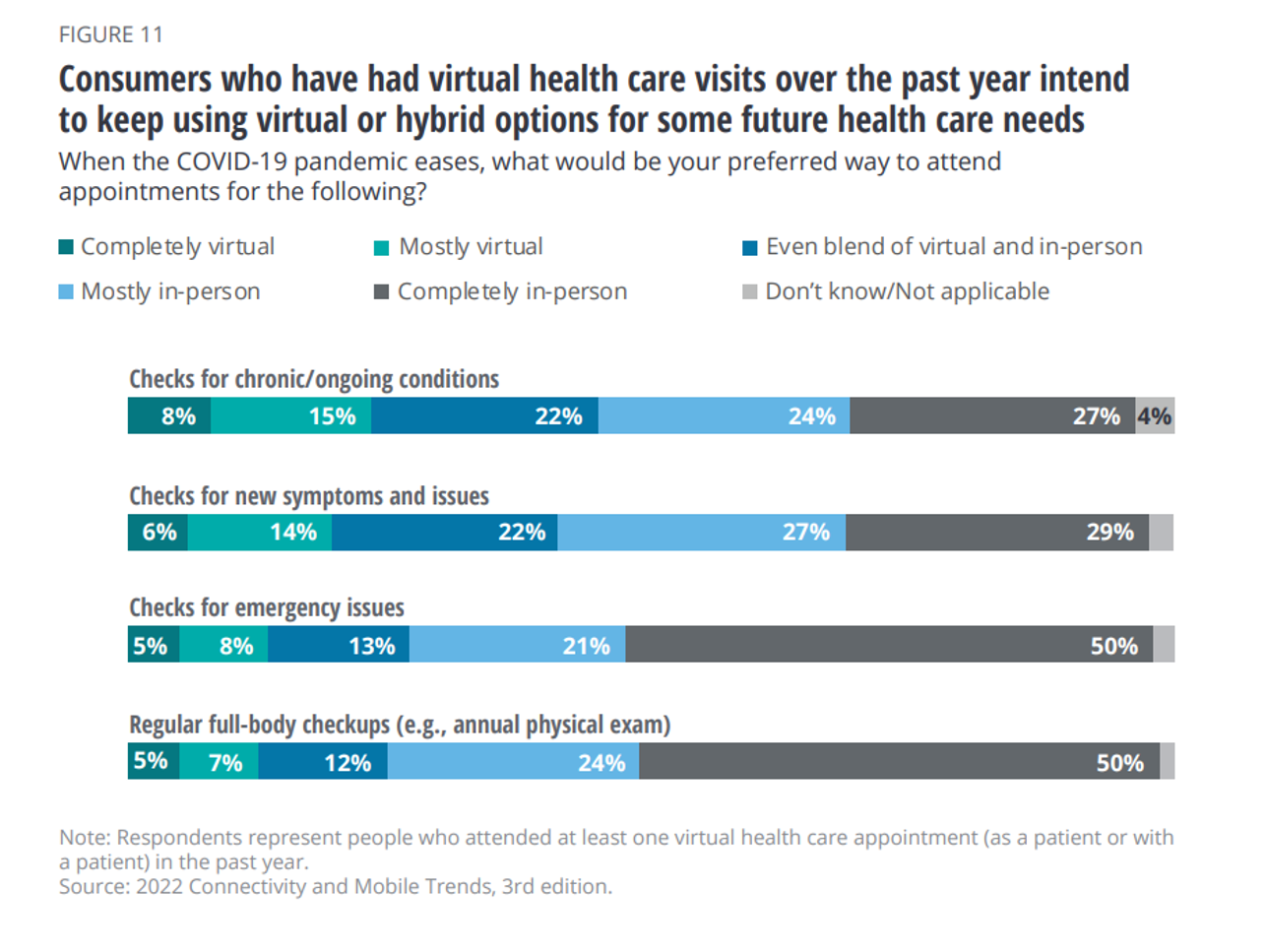“Almost overnight, lines blurred between consumers’ physical and digital worlds, and home became the headquarters for virtual working, learning, fitness, health care, shopping, socializing, and entertaining.”

That blur has reshaped peoples’ Everyday Normal we learn in Mastering the new digital life from Deloitte, a survey conducted among 2,005 U.S. consumers in the first quarter of 2022. The report is part of Deloitte’s ongoing Connectivity and Mobile Trends research in this third iteration.
The report covers peoples’ new digital transformations for work, school and health; in this post, I’ll focus on the last element, noting the new mastery of digital life is indeed a “blur” across peoples everyday life-flows.
In the chapter titled “Managing wellness,” Deloitte recognizes that consumers “turned swiftly” to virtual health care to stay safe and well during the pandemic.

By early 2020, most U.S. patients had not experienced telehealth visits….then, COVID-19 emerged, and people pivoted to meet up with health care providers via virtual platforms.
The first bar chart shows that patients as health consumers “mastering digital life” intend to partake in hybrid health care options in the future. Hybrid is many workers’ preferred office-mode, and here we see a blur of that ethos into people’s health care, as well. 
It’s the convenience, hygiene and safety, and opportunity for more frequent visits that’s attracting health consumers to virtual care.
But challenges remain, we see via Figure 10 from the study, such as the lack of human touch and desire for face-to-face visits for some patients. Other challenges cited include connectivity issues (a barrier for “digital life mastery” for workers and students, as well as patients), and poor design for making appointments or engaging in the visit itself.
![]()
Many consumers are in health care DIY mode, using wearable technologies to track physical activity and health metrics. Figure 12 from the report quantifies these data findings from the survey, telling us the most popular ways to use smartwatches and fitness trackers for health are to count steps per day, to monitor pulse rate, to track calories and nutrition, to watch heart health (ECG) and sleep quality, and to provide reminders and nudges to exercise and move.
“Users give wearables a big thumbs up,” Deloitte observes from the study. “At least seven in ten said their smartphones/fitness trackers have improved their fitness and health — with three in 10 saying their devices have made their fitness and health ‘significantly better.”
An overall challenge to mastering our digital lifestyles is the concern for privacy and security: the study found that one-third of respondents had had at least one kind of security breach of their data in the past year. Top breaches happened as social media accounts hacked, credit cards hacked, and falling for online scams. Even with growing awareness of data breaches, though, Deloitte did not find that consumers were taking dramatically new steps to secure their online lives.
Health Populi’s Hot Points: Another unintended consequence of mastering our digital lives is tech fatigue, Deloitte explains. While there is somewhat less frustration dealing with the complexity of managing devices, there remain challenges in doing so. One in 4 consumers said they were overwhelmed with managing their devices and subscriptions.

The risks of feeling tech fatigue rise with the number of devices and number of people working and learning from home, the last chart illustrates.
“Tech companies should heed the pain points of their biggest fans and continue making devices easier to manage and secure,” Deloitte recommends.
In their conclusion, Deloitte asserts that the companies to be successful in delivering tech to consumers looking to master their digital lives must deliver great experiences, and also help consumers mitigate frustrations with the devices, security risks, and tech fatigue.
This strategic prescription is even more important for organizations seeking to service health consumers with digital tech solutions and services as health citizens’ lives blur, digitally, across their everyday life-flows.





 Interviewed live on BNN Bloomberg (Canada) on the market for GLP-1 drugs for weight loss and their impact on both the health care system and consumer goods and services -- notably, food, nutrition, retail health, gyms, and other sectors.
Interviewed live on BNN Bloomberg (Canada) on the market for GLP-1 drugs for weight loss and their impact on both the health care system and consumer goods and services -- notably, food, nutrition, retail health, gyms, and other sectors. Thank you, Feedspot, for
Thank you, Feedspot, for  As you may know, I have been splitting work- and living-time between the U.S. and the E.U., most recently living in and working from Brussels. In the month of September 2024, I'll be splitting time between London and other parts of the U.K., and Italy where I'll be working with clients on consumer health, self-care and home care focused on food-as-medicine, digital health, business and scenario planning for the future...
As you may know, I have been splitting work- and living-time between the U.S. and the E.U., most recently living in and working from Brussels. In the month of September 2024, I'll be splitting time between London and other parts of the U.K., and Italy where I'll be working with clients on consumer health, self-care and home care focused on food-as-medicine, digital health, business and scenario planning for the future...